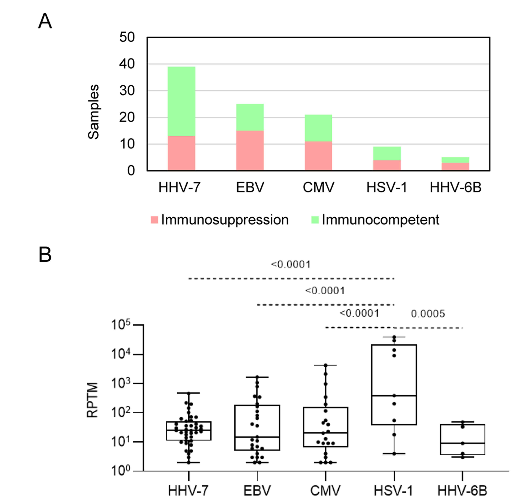Two groups of investigators in China used next-generation sequencing to identify EBV, HHV-7, HSV1 and CMV as the most common herpesviruses in immunocompetent pneumonia patients.
HHV-6 can cause an opportunistic “idiopathic” pneumonia in transplant patients. Often, HHV-6 can only be detected from bronchial lavage or lung biopsy, and is typically not detected in plasma (Seo 2015, Zhou 2019). HHV-6 lung infections can double the mortality rate (Hill 2019). Unanswered is the question of whether HHV-6 causes pneumonia in immunocompetent people, or serve as a co-factor that worsens their prognosis in cases of pneumonia caused by other agents?
Two new reports from multiple institutions in China, demonstrate that HHV-6 is reactivated primarily in the immunocompromised. Investigators from a hospital in Beijing studied the bronchial lavage fluid (BALF) of 200 immunocompetent hospitalized patients with various pulmonary conditions. They used metagenomic next-generation sequencing (mNGS) to assess the presence of various pathogens, and found herpesvirus infections in 73 (37%). The most common herpesviruses were HHV-7 (19.4%), EBV (12.4%) and CMV (10.4%). The patients with herpesvirus infections had longer hospital stays and alterations in the lung’s microbial composition (Zhang 2025).
A second group of investigators from Nanjing Medical University studied BALF and nasopharyngeal swabs from 100 patients with various pulmonary infections using mNGS (Liu 2024). Patients known to have COVID-19 or influenza A infection were excluded from the study.
The investigators found EBV and HSV-1 in 15-25% of pulmonary specimens; other herpesviruses were found less often. HHV-6B was detected in only about 1% of specimens, and HHV-6A in none. Patients with any herpesvirus detected were much more likely than patients to be admitted to intensive care and to have a fungal infection detected, particularly infections with Pneumocystis jirovecii and Aspergillus fumigatus compared to patients without a herpesvirus infection (100% vs 63% P<0.0001).
The findings are summarized in Figure 1.

Figure 1: (A) Frequency of herpesvirus detection in immunosuppressed and immunocompetent people and (B) Abundance distribution of herpesviruses in patients with herpesvirus detection (Zhang 2025).
Whether herpesvirus co-infections increase the likelihood of pulmonary fungal infections, or vice versa, cannot be determined by this study. Most important for this newsletter, lung disease involving HHV-6 appears to be primarily a concern for the immunocompromised.
Read the full text: Liu 2024 , Zhang 2025.

